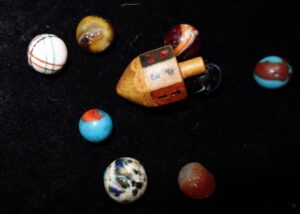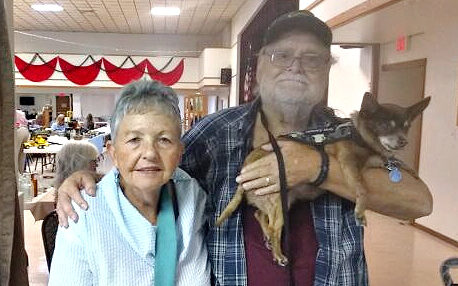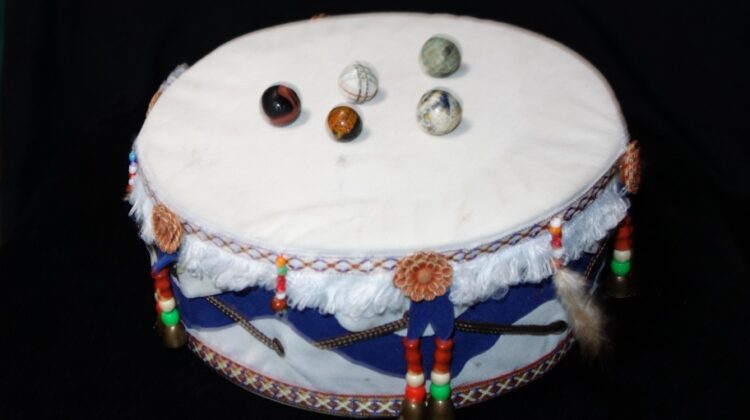
We enjoy wandering through old historic newspapers from all across the United States. You may have read our stories “Marbles in the Saddle Bag,” “Grandpa’s Marble Stories, ” and “A.L. Dyke: Man of Mystery”
We found our inspiration for these stories in the online digital newspaper archives of the Library of Congress.[1] The online site Chronicling America is sponsored jointly by the National Endowment for the Humanities and the Library of Congress. By using both Chronicling America and United States Newspaper Directory you can search newspaper pages from 1690 to the present.
Sometimes we find stories, such as those in this post, that we want share with you. Of course, we realize that some information in the old newspapers, and sometimes the newspapers themselves, are highly politicized and polarized.
Add A Twist
Newspapers editors in the 19th century took entire stories from other papers and printed them. Some of this “news” does attribute the name of the original paper, but others do not. And it is certainly not always verified news stories which were republished. Even when we cannot corroborate information we find in the newspapers, reading these old sources is an addictive and enjoyable hobby.
Some newspapers were carefully crafted to slant the news in a particular way and specific voice to readers in their geographic coverage such as farmers, fishermen, families and so on. For example, some readers need to know about shipping news; others need to check on livestock, stock, or commodity prices, and so on.
Famous & Prize-winning Newspapermen
Before you dismiss 19th century newspapers consider this: a number of famous and prize-winning authors also wrote for newspapers. Samuel Langhorne Clemmons is an example. He accepted a job as reporter for the Virginia City, Nevada, newspaper the Territorial Enterprise in 1862. It was then that Clemmons adopted the pen name Mark Twain.
Clemmons was born in Florida, Missouri. He was raised in Hannibal and he apprenticed and served as a Captain on steamboats on the Mississippi. On the river mark twain was called by the leadman aboard the boat when the boat was in safe water (about twelve feet).[2]
Mark Twain is one in a long list of authors who wrote for the newspapers. Others include: Charles Dickens (1812 – 1970); Bram Stoker (1847 – 1912) who wrote for the Dublin Evening News; P.G. Wodehouse (1881 – 1942) appeared in the London The Pall Mall Gazette; Ernest Hemingway (1899 – 1961) who wrote for the Kansas City Star early in his career; and Pulitizer-winning syndicated columnist Connie Schultz (1957-) who was a reported before becoming a columnist.[3]
With all this in mind let’s look at some remarkably odd, even mysterious, marble stories from over one hundred years ago. Watch carefully for disinformation, xenophoibia, or misinformation. After the stories we will return to the idea of disinformation, misinformation, and mal-information.
The Drum: “An Observing Baker”
This delightful little story is from the Fairhaven Herald. It was published in October 1892[4]. The newspaper’s coverage was both Fairhaven and Bellingham, Whatcom County, Washington. Fairhaven was settled the 19th century on Bellingham Bay. This land was the ancestral home of the Salish peoples. The community slowly merged with Bellingham.
“During a war between Austria and Turkey a baker in his cellar kneading bread noticed a slight noise rising and falling at intervals, which seemed to come from a distant corner of his cellar. He stopped his work, and tracing the sounds discovered that they were caused by a few marbles dancing up and down on the head of a little drum his child had left there.
The majority of persons would have been satisfied to attribute the motion of the marbles to the rumbling in the street, or to the occasional firing of guns, but this man was an observer.
Surprised at the perfect regularity with which the marbles jumped from the drum head, he put his ear to the ground and noticed a distant tapping. He recalled how as a boy he had heard from one end of a long log a companion scratching with a pin upon the other end, and he judged that the earth was just such a conductor of sound as the log had been.
Suddenly it flashed upon him that what he heard was the sound of a pick, and that the Turks were doing what had so long been feared, undermining the city. The news was carried to the Austrian general, examination made, a counter mine prepared and exploded, and the Turks put to flight. —Youth’s Companion”
Corroboration
This story sounds perfectly plausible and believable to us. We like it, but it is impossible to corroborate. Neither dates nor city are given. The only “war” we could find between Austria and Turkey occurred between 1788 – 1791 and we cannot find historical sources which confirm that the Turks ever used tunneling as an act of War.
The only tunneling in war that we know about is what happened in late July 1864 when the 48th Pennsylvania dug under Confederate lines during the battle of Petersburg,Virginia.[5] And even in Virginia the soldiers didn’t dig under a city or town.
The unknown author also mentions the “occasional firing of guns” so whatever Austrian city the baker in was under some sort of seige. The guns would be artillery or mortars.
Youth’s Companion
The only scrap we are left with is Youth’s Companion. This is the magazine of attribution. It was a very reputable and popular magazine which was published in Boston from 1827 – 1929. In the 1890s when the story was published in the Fairview Herald, the magazine was becoming a family magazine.[6]
A Fun Story
So, little can be confirmed or denied in this first story. It sure sounds like it could be true. The physics are probable. We haven’t seen it published in any other newspaper. But that’s fine with us too. Perhaps it never happened. The only conclusion we can draw from it is that it was just a fun and delightfull little story meant only to amuse and enjoy. If this is the case, then it achieved its goal. Click on the Contact button and tell us what you think about the baker’s story.
Tee-to-tum
One of the concerns that parents, and often lawmen and clerics, have had with playing marbles is the deep-seated belief that the game of marbles is inherently gambling. We discuss this point in “Marbles in the Saddlebags” It was and many still believe that playing marbles for keeps can be nothing but gambling, and boys would hardly consider playing a game for “funsies” in which you had to give back your hard won agates and swirls at the end of the game. And adults have been arrested and jailed for devising and playing such marble-based “games”.
The San Juan Islander
With this idea that playing marbles is gambling, consider this next story from The San Juan Islander, Friday Harbor, Washington. The story was published at the end of December in 1911. The Islander was published from 1898 until 1914.[7]“The San Juan Islands are an archipelago of more than 170 named islands and rocks. …” The Islands lie in Puget Sound off the coast of Washington. “The climate on the Islands is temperate year-round, and the area gets half the amount of rain that Seattle does. The islands of San Juan, Orcas, and Lopez are the most populated….”[8]
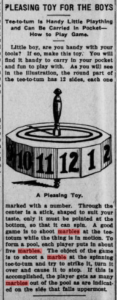
Pleasing Toy For The Boys
Tee-to-tum is a Handy Little Plaything and Can be Carried in Pocket—How to Play Game.
“Little boy, are you handy with your tools? If so, make this toy. You will find it handy to carry in your pocket and fun to play with. As you will see in the illustration, the round part of the tee-to-tum has 12 sides, each one marked with a number. Through the center is a stick, shaped to suit your taste, only it must be pointed at the bottom, so that it can spin. A good game is to shoot marbles at the tee-to-tum while the thing is in motion.
To form a pool, each player puts in about five marbles. The object of the game is to shoot a marble at the spinning tee-to-tum and try to strike it, turn it over and cause it to stop. If this is accomplished, the player gets as many marbles out of the pool as are indicated on the side that falls uppermost.”
Put And Take
Well, just when you thought that you knew at least most of the marble secrets, here is a totally new one. Tee-to-tums, Put and Take, and similar tops were designed to gamble. There was simply never any other purpose.
We found one brass top similar to this one in an antique store in Virginia once, and in June 2020 we bought this Put and Take top in an antique shop in Semmes, AL
Our Put and Take top is wood, 8-sided, and 2” tall. The one featured in the story has twelve sides. The indicators on our top are paper on wood. It is in good condition, but apparently very well used. We cannot determine the age, but it is apparently from the 1930s. These tops exist in many different countries and that they are made from everything from brass to cow bone. But we almost never seem them in the shops that we visit.
Besides the twelve-sided tee-to-tum and our eight-sided put-and-take, the six-sided tee-to-tum was known to the ancient Greeks and Romans. It has always been a gambling game. Put and take, also a gambling toy, has been played since medieval times.[9]
Regardless of the number of sides and different names, these type toys all have symbols on the sides which instruct the players to either put money in the pot or take from the pot. Or marbles in the “pool”.
Mathematics: It’s All Greek to Us!
Adding marbles to the game of Tee-to-tum is the only thing different about the top in the story. We hope that you are better at math than we are. The unknown author tells boys to whittle a twelve-sided toy. Question: Is it easier to win playing with a six, eight, or twelve-sided top? Next question: What does a fast marble do to your chances on a twelve-sided top? And, finally, look back at our Put and Take: one side says “All Put”: put all your money in the pot! Another side reads “Take All”! Take all the money from the pot. Why did the author of the story leave this option off his top?
Fun Fact about Put and Take
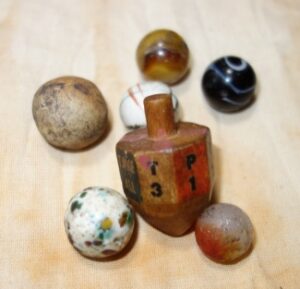 Put and Take is a form of Tee-to-tum,. Rather than being centuries old, it is generally believed that it dates to World War I (1914 – 1918). “The full history of the game is unclear but it is thought to have been invented by a soldier in the trenches. The original game was made from a brass bullet that the soldier shaped into a spinning top with six sides. Each side had an instruction that was either Put one, Put two, Put all, Take one,Take Two, or Take all. The top was spun by players, who each put an ante in the pot (said to be a cigarette), and depending on how the top fell either took or put how many cigarettes indicated. …”[10]
Put and Take is a form of Tee-to-tum,. Rather than being centuries old, it is generally believed that it dates to World War I (1914 – 1918). “The full history of the game is unclear but it is thought to have been invented by a soldier in the trenches. The original game was made from a brass bullet that the soldier shaped into a spinning top with six sides. Each side had an instruction that was either Put one, Put two, Put all, Take one,Take Two, or Take all. The top was spun by players, who each put an ante in the pot (said to be a cigarette), and depending on how the top fell either took or put how many cigarettes indicated. …”[10]
Comments about The Story
There is really nothing to corroborate in the story, but we do have a few comments. First, can you even imagine a time in America when a child could possibly “use his tools” to create a Tee-to-tum from scratch? It is hard to imagine that in 1911 out on San Juan Island a child could pull together the piece of wood needed, the paint, the stick and the tools needed to craft this
We would love to know who the author of the story is. We cannot find this story in any other newspaper. Did the unknown author invent the idea of playing marbles with a gambling toy? After centuries of marbles being looked on negatively as gambling devices, whomever he is simply conceded and brought marbles out of the shadows. He introduced a known gambling device to be used with marbles. We can only imagine how many tops were confiscated on sight!
Buster Quits Jingling
This next story is for all you animal lovers.
Buster Quit Jingling
He Used to Until Doctor Took Marbles From Stomach
Chicago.—Buster is back at home again, romping and feeling much lighter in spirits and weight. Buster is a prize Boston terrier belonging to J. Nahser. One of the dog’s tricks is to retrieve a ball thrown by four-year-old Earl Nahser.
Some time ago Earl and Buster began playing marbles. Earl would throw one and Buster would tear through the house after it. But somehow Buster never brought them back. It was noticed that when Buster ran through the house he made an odd sound, like pieces of broken china jingling. One day Mr. Nahser rubbed Buster’s stomach. It jingled.
Veterinarian T.A. Kragness was called and removed nine marbles.”[11]
True or false? Well we fostered a Terrier once who was certainly not a “prize” example of dog intelligence. Still, she was precious to us. And while we never knew her to swallow marbles she did odd and perplexing things that we have never seen any other dog do. And she often did common things in a very uncommon way. She was a perplexing wonder. So on the face of it the story sounds plausible to us.
Just out of curiosity we decided to see if there was any historical record of the veterinarian Dr. T.A. Kragness in Chicago. Yes, there was and is! His name was Dr. Theodore Andrew Kragness and his Kragness Animal Hospital dates back to 1908. Our story is datelined May 14, 1915. At first the Hospital focused on large animals like cows and horses but it slowly transitioned to small pets. And today Dr. Craig Kragness, who is the third generation, leads the practice. Dr. Craig Kragness plans a seimi-retirement soon.[12]
We called the Kragness Hospital but staff could not answer the hypothetical question “Can a trained veterinarian feel marbles in a dog’s stomach?” We were satisfied that the Hospital is still open and doing well after over 100 years.
So, let us know what you think. We think the story is absolutely probable.
One Last Story
Still more remarkable [than a jingling Boston terrier] is the case of the Cincinnati German who accidentally contracted the marble disease.
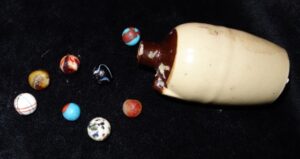
Some Odd Developments
“He was accustomed whenever he was in the least degree excited to drink a gallon of beer, and for that purpose kept a large pewter measure, holding precisely a gallon, on his dining-room table. Being one day engaged in an earnest pork argument with a neighbor who had called at his house, he hastily took up the measure and drained it. There was only a half gallon of beer in the measure, although the servant girl thought she had filled it.
The German’s small boy had taken the liberty of putting all his marbles in the measure on the previous evening, and had thus half filled it. In his excitement the worthy German swallowed the entire two quarts of marbles, and a month later broke out with an eruption of assorted marbles of all sizes and materials, greatly to the relief of the small boy, who had mourned his treasures as hopelessly lost.”
Four hundred and seven marbles made their made their way to the surface of the suffering man, but, after they had been gathered by the physician and nurse, he recovered, and, although his surface is badly pitted, he is now as well as usual.
And, finally, the most remarkable thing of all is the ease with which the public swallows these stories of needle, teeth and marble diseases. Of all the feats of swallowing this is undoubtedly the most wonderful, and there seems to be hardly a man, woman or child in the community who is not capable of swallowing any and all stories of this general character. —[N.Y. Times.”[13]
A Little Back Story
This story was published in Sacramento in June of 1881. Note the byline: the venerable New York Times which was first published in 1851. The setting for the story is Cincinnati. The protagonist is a “worthy German.”
There was a “mass migration” of German Nationals and German speakers into Cincinnati in the 1830s and in the 1840s and 1850s the German population increased almost tenfold. But the largest wave of the German population occurred in the 1880s. In 1890 57% of the Cincinnati population of about 300,000 were German or they had German parents. At the turn of the 20th century German was taught in schools and there were German newspapers, churches, and societies.[14]
Das Biergarten
So, even in California, people could relate to the idea of Germans in Cincinnati. And everyone knows that Germans love beer! Yuengling, after all, is the oldest American brewery still operating. It was founded by David Gottlieb Yuengling from Württemberg, Germany.
Best Brewing, established by German immigrant Phillip Best, later became Pabst Brewing Company; Joseph Schlitz Brewing Company is yet another Milwaukee-based brewery with German roots.
Miller Brewing Company was founded by Frederick Miller, a German immigrant, again in Milwaukee. A beer that has been off the market for awhile now is Falstaff. It was originally brewed in St. Louis by the German immigrant Lemp family. So, yes, Germans were instrumental in the development of the American beer legacy.
“An Earnest Pork Argument”
We simply have no idea what an earnest port argument was or is. Nor a frivolous pork argument for that matter. But, like the beer inference, this xenophobia comment is in reference to the German participation in the 19th century Cincinnati pork industry. Can you imagine that Cincinnati was often called “Porkopolis” in the 19th Century?[15]
Dis-Mis-and-Mal Information[16]
In our introduction to this story we asked that you watch for dis-and-misinformation in the newspaper stories. Frankly, some of the stories, like the jingling Boston terrier, are just fun and interesting. Some, however, are not so innocent and they have a hidden or apparent message. Case in point is the story about the “marble disease.”
Misinformation can be as innocuous as posting incorrect information. It’s typically a user error, benefiting no one and detached from any larger political or economic scene. For example, how many times online have you seen a post that identifies an Akro patch as a Christensen? A Cairo as a Heaton?
Next is disinformation. Disinformation is both intentionally false and meant to cause harm. It can be motivated by the desire to make money, have greater political influence, or sew chaos for chaos’s sake. When an individual tries to sell that Akro as a Christensen we are dealing with disinformation.
The Internet is filled with disinformation; social media is no exception. With AI now able to replicate anyone’s voice and image it is growing more and more difficult to trust what you are looking at online. Disinformation monetizes our anger, confusion, fear, and support.
You might dismiss this idea when considering marble collecting, but we do encourage you to be more cautious than ever especially when money is about to exchange hands.
And finally, a term you may not have heard of. Yet. Malinformation is true, but the sharing of it is meant to cause harm. Harm is derived from either the true statement being shared out of context or at a particularly vulnerable point for the malinformation target. Malinformation occurs on a mega-political stage.
It might also happen at marble shows when true stories are told door to door. Although true, the collector who is the target of malinformation may lose a sale and may have difficulty continuing to share information. It can prove messy to clear up this type situation. And it happens more often than you may think.
That’s All, Folks
We hope you enjoyed these one hundred-plus year old stories. Most are fun and they let you go back in your mind to another time and place. Some make you wonder: Did that really happen? Could that really happen?
We like the morality play of the marble disease. And how many people do you think failed to real the last two lines of that story? We can only imagine that for days the story went around person to person and it was told as the truth! Now what is the story? Misinformation? There was no political or monetary motivation.
Please enjoy your marbles and the whole process of collecting. It can be very fulfilling. But be careful. If someone tells you in person that he wants $160.00 for his grandfathers’ marbles which were found on the family farm in a barn no one had used since 1952 then listen politely. It may be a wonderful story. Then look at the marbles. If you like non-glass and see Benningtons, clays, stone, cobbles and other ceramic then you might buy them. If you like whatever you see in the old marble bag then buy them. Buy the bag too. And the story. Don’t haggle.
But please be cautious whether you are face to face with someone or on the Internet. Things are simply not always what seem. We have been collecting for twenty years and we can assure you that things are getting “curiouser an curiouser.”
- https://chroniclingamerica.loc.gov/ ↑
- Mark Twain begins reporting in Virginia City | July 6, 1862 | HISTORY 6/10/2024 ↑
- Check https://daveastoronliterature.com/2020/11/29/novelists-who-navigated-from-newspapers/ (6/12/2024) if you want to learn more. ↑
- October 14, 1892, Image 2
About Fairhaven herald. [volume] (Fairhaven, Wash.) 1890-????↑ - Online article “Calamity in the Crater” @ https://www.battlefields.org/learn/articles/calamity-crater (6/12/2024) “After weeks of inconclusive fighting at Petersburg, a vital point on the rail lines supplying the Confederate capital of Richmond, Va., Union troops looking to break the stalemate put their civilian skills to work in an attempt to break the impasse. Many members of the 48th Pennsylvania, part of Maj. Gen. Ambrose E. Burnside’s IX Corps, were coal miners by trade. They proposed tunneling from the bottom of a ravine near their position into the rear of the Confederate lines and filling the mine with black powder. After the ensuing explosion, Union troops would be able to exploit the break in the Confederate line and bring a swift end to the war. But nothing went to plan and Lt. Gen. Ulysses S. Grant called the July 30, 1864 Battle of the Crater “the saddest affair I have witnessed in this war.” ↑
- “In 1929, it merged with American Boy Magazine which continued to be published until 1941.” @ https://www.chipublib.org/fa-youths-companion-collection/ 6/10/2024 ↑
- The San Juan islander. [volume], December 29, 1911, Image 6
About The San Juan islander. [volume] (Friday Harbor, Wash.) 1898-1914 ↑ - https://stateofwatourism.com/get-to-know-the-san-juan-islands-of-washington-state/ 6/10/2024 ↑
- Teetotum | Teetotum | Ancient Spinning Top Game Piece | Britannica 6/13/2024 ↑
- Check out the site https://averweij.web.cern.ch/averweij/top-pt.htm (6/13/2024) which has the most extensive collection of Put and Take photographs, including one photo of ours, that we have ever seen! ↑
- The Leavenworth echo. [volume], May 14, 1915, Image 4
About The Leavenworth echo. [volume] (Leavenworth, Wash.) 1904-current The Leavenworth Echo began publication in 1904 and, to our knowledge, is still published today. Its geographic coverage is Leavenworth, Chelan County, Washington. While Leavenworth is now a Bavarian-style village and a top tourist destination in the Pacific Northwest, the town started in 1903 as home to the second-largest sawmill in Washington State. ↑ - About Kragness Animal Hospital – Chicago, IL 60628 Veterinarian 6/10/2024 ↑
- Sacramento daily record-union. [volume], June 20, 1881, Image 5
About Sacramento daily record-union. [volume] (Sacramento [Calif.]) 1875-1891 ↑ - From search in Microsoft Copilot in Bing ↑
- Nuss, Hudson. “Porkopolis: How It Came To Be And Its Legacy.” Undergraduate Research Thesis. The Ohio State University, 2023. ↑
- https://guides.iona.edu/researchessentials/disinformation 6/10/2024 ↑

